Marcel van Marrewijk's Blog, page 136
January 26, 2017
From the taxes office to empowering young entrepreneurs
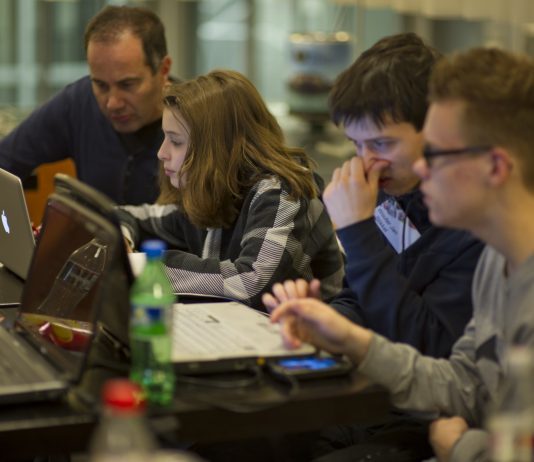
Alain Raap is becoming quite the name in connecting and empowering young entrepreneurs, and when I say young, I mean 13 years old young. I had the pleasure to interview him recently after he published an article about his story and why young people should innovate businesses, which you can read here in Dutch.
Alain has worked for 30 years in the Dutch taxes office and and was only five years ago that he had his chance to innovate and bring his own ideas to the department. In a contest for the most innovative ideas he proposed that the government gets closer to young people and make the request for taxes return easier. The idea came from his own house, where his sons were having trouble asking for their taxes back due the complexity of the system. His solution? An easy mobile app.
The app wasn’t concretised immediately but it lead him to meet a whole new world of young programers, hackatons and communities that were working to make mobile apps what we know nowadays. With his vast network and knowledge and the new acquired relationships he found himself connecting those young entrepreneurs to the people who needed them and vice-versa. At the same time he started teaching teenagers his own job, programming! In that way he empowered those youngsters and in a way, himself.
When I asked Alain what he thinks that the taxes agencies should do he replied that they should what every company nowadays should do to keep relevant and alive: be open. Open to the new generation to get in, sniff around and make the necessary changes. Let the door open and fresh air come in, that’s only way of truly innovating. Might be scary but it’s definitely worth it.
Alain is a great example of how in society 3.0 we don’t do only one thing. We don’t fit in only one box, but in a lot of them. Even if you work in one of the most traditional organisations you can be an innovator, maybe if not inside your company somewhere else. So what is it that you want to do? Here is a speech – one of Alain’s favourites – to inspire you today.
To know more about Alain and his initiatives you can check his linkedin page .
The post From the taxes office to empowering young entrepreneurs appeared first on Seats2meet.
Waarom mindfulness zo waardevol is voor ZZP’ ers
January 25, 2017
Trabalho remoto: qual será o seu futuro?
 Futurista Beia Carvalho fala sobre o trabalho remoto e a importância das gerações na concepção desse modelo
Futurista Beia Carvalho fala sobre o trabalho remoto e a importância das gerações na concepção desse modeloUma chamada por Skype e está feita a conexão entre São Paulo e Curitiba. O dia, até então calmo, ganhou uma série de inquietações após alguns minutos de conversa. Afinal, será que o trabalho remoto vai mesmo dominar o mercado? Qual será seu futuro?
Foi com esses questionamentos que se seguiu uma conversa inspiradora por videoconferência, bem ao estilo ‘trabalho de qualquer lugar do mundo’, com Beia Carvalho, palestrante futurista e fundadora do Five Years From Now, que trata da transição para uma nova era, o que ocorre exatamente agora, em seu emprego, sua cidade, ou seu país.
 Beia Carvalho é especialista em futuro e, além de palestrar, também utiliza seu canal no YouTube para dar dicas, como a recente série sobre home office / foto: Felipe Feca – divulgação
Beia Carvalho é especialista em futuro e, além de palestrar, também utiliza seu canal no YouTube para dar dicas, como a recente série sobre home office / foto: Felipe Feca – divulgaçãoEmbora o tema ‘teletrabalho‘ esteja em alta, é importante ressaltar por quais motivos ele segue em crescimento e como ele pode impactar no mercado.
“Acho que o negócio do home office está aí e veio para ficar. Por que? Porque ele satisfaz muitas necessidades e tem muitos benefícios.”
Segundo a futurista, essa atividade atende expectativas :
Individuais
O profissional gasta menos energia com o deslocamento até o escritório, por exemplo, além de se tornar mais produtivo e aderir a um estilo de vida mais flexível.
Empresariais
Aqui é possível considerar que determinadas atividades podem ser feitas de casa, sem gastar eletricidade, otimizando o espaço físico e motivando o colaborador com uma jornada também mais flexível.
Urbanas
A ausência de deslocamento impacta diretamente no fluxo do trânsito, principalmente nas grandes cidades como São Paulo.

Há ainda a questão do empreendedorismo, que está cada vez mais presente na sociedade. “Em uma era pós-industrial, em que cada vez mais um cidadão especialista em algo torna-se sua própria marca, não é preciso ter um lugar físico. Ele pode expressar isso no seu home office, ou no bar office, na padaria office, ou no coworking”, aponta Beia.
Essas são algumas das questões que permitem ao trabalho remoto, principalmente executado em casa, uma estimativa de vida longa. É importante lembrar que essa é uma tendência que se encaixa em determinados perfis de negócios.
“Se falarmos que o home office vai ser 100% o futuro do trabalho, estaremos dizendo que nunca mais vamos trabalhar fisicamente juntos e que faremos tudo dentro da nossa casa, o que não é verdade.”
Beia reforça essa questão, pois, mesmo que seja uma ideia empolgante e que se trate de uma tendência, não são todos os profissionais que poderão usufruir dessa modalidade.
Há certas atividades, principalmente as industriais, que precisam de times de especialistas trabalhando juntos, em um mesmo espaço, em um projeto, ou para que se finalize um produto, ou até mesmo um serviço específico.
É uma questão de gerações
Para a palestrante, o trabalho molda a sociedade. Ela usa como exemplo a sociedade escravagista, em que as pessoas entendiam que trabalhar era algo somente para os escravos, os quais eram adquiridos como propriedade. Como se sabe, essa linha de pensamento guiou a história por muito tempo e acabou por refletir na cultura.
“Há toda uma relação social de como você, sua família e seu país prosperam a partir do ponto de vista de que o trabalho é realizado por escravos. A hora que se muda isso, se muda também a cultura”, explica.
O que existe hoje é uma mescla de gerações mais antigas com as chamadas Y e Z, que são conhecidas como não lineares, ou seja, que seguem o raciocínio de que é possível ter várias coisas ocorrendo ao mesmo tempo.
“As gerações mais velhas não acreditam que as mais novas consigam fazer tudo ao mesmo tempo. Elas veem e não acreditam.”
A flexibilidade e a versatilidade presente na forma de trabalho das gerações atuais se encaixam perfeitamente nas demandas do trabalho remoto, sendo esses alguns dos fatores que colaboram para essa tendência ser reforçada.
Inclusive, profissionais freelancers, que são uma parcela bastante representativa dentro do teletrabalho, já estão em ascensão e terão ainda mais destaque no futuro. Isso porque, como aponta a futurista, uma das profissões que devem ser mais requisitadas é a de especialista em montar equipes, alguém dedicado a encontrar trabalhadores qualificados, que estão no home office, para compor times para determinado projeto.
“São pessoas que sabem montar times para resolver problemas de uma indústria, de uma fabriqueta, de uma franquia de roupa, de um governo, etc. Essa é uma profissão do futuro que vai ser super bem remunerada.”
Muitos desses profissionais estão inseridos no mercado freelance e poderão ser bastante procurados. Então vale a pena ficar de olho nessa análise e garantir um lugar nesse futuro do trabalho remoto, que se aproxima cada vez mais da realidade dos brasileiros.
The post Trabalho remoto: qual será o seu futuro? appeared first on Seats2meet.
Renda extra: quando um freela complementa o orçamento

Nem todo profissional se dedica integralmente à carreira de freelancer. A flexibilidade dessa modalidade é tanta, que até mesmo quem possui um emprego fixo pode se beneficiar de um freela para garantir uma renda extra.
É assim que Renan Bonfim encara o mundo freelance. Analista de mídias digitais na S2Publicom, ele mergulha nos horários alternativos ao do trabalho para entregar qualidade para sua carteira de clientes.
Formado em publicidade e propaganda, ele começou a captar jobs por meio do blog Publicitário Pobre, o qual mantinha ativa antes de aumentar a demanda de freelas e ter a agenda completamente tomada.
 Renan Bonfim é analista de mídias sociais e garante uma renda extra oferecendo serviços como edição de vídeo e de redação nas horas vagas / foto: acervo pessoal
Renan Bonfim é analista de mídias sociais e garante uma renda extra oferecendo serviços como edição de vídeo e de redação nas horas vagas / foto: acervo pessoalRenan faz parte das estáticas sobre o freelancer brasileiro, divulgadas pelo Trampos.co em 2015.
O estudo mostra que 42% desses profissionais trabalham nessa modalidade nas horas vagas, sendo que 45% tem o objetivo de aumentar a renda.
Quando a primeira oportunidade surgiu, o analista de mídias sociais pensou em cobrar um valor simbólico pelo trabalho, que demandava pouco tempo. Foi então que uma porta se abriu: “A partir deste momento vi que poderia ter uma renda extra, sem ter que abandonar o trabalho aqui na agência. Após conversar com alguns amigos, decidi cobrar o preço justo e com a grana dos freelas consegui conquistar algumas coisas bem legais, que demoraria um tempo maior com o salário da agência.”
Entre os benefícios do trabalho freelance, Renan destaca:
Melhor noção de mercado e de como se vender
Mais disciplina no trabalho
Mais noção de organização
Para ele, esses valores adquiridos refletem no desempenho do trabalho fixo também, e acaba impactando positivamente tanto pessoalmente quanto para as empresas.
Criação é a palavra de ordem
Ter a oportunidade de desenvolver outras habilidades, diferente das exercidas no emprego fixo, é mais uma vantagem dos freelas. Renan explora bastante isso.
“Apesar do cargo CLT ser voltado para a análise, tenho uma veia criativa e um interesse muito grande na criação. Então presto serviços de design, redação e edição de vídeo. ”
A pesquisa do Trampos.co indica exatamente a criação (12%) como uma das principais áreas de atuação dos freelancers. O design (27%) e o jornalismo, com a produção de conteúdo (10%), também estão no topo da lista.
Ao analisar o mercado atual, o publicitário encara essa possibilidade de desenvolvimento como uma forma de dar o passo inicial para o mundo do empreendedorismo, pois é possível entender melhor o mercado por conta própria e “despertar o interesse de se ter como próprio chefe”.
O fator financeiro é apontado como outro propulsor:
“Temos muitos profissionais talentosos em todas as áreas. Mas as empresas, normalmente, não os reconhecem financeiramente, oferecendo salários não tão atraentes e até mesmo injustos para os cargos. Isso gera uma certa inquietação nas pessoas.”
Renan acredita que há mercado para o freelancer e que é possível investir em trabalhos extras, inicialmente, até que se possa investir nos freelas integralmente.
Mas para que essa transição ocorra é preciso disciplina e organização.
Como se organizar
Manter a ordem é primordial em qualquer trabalho, mas quando se trata de jornada dupla, é bom ter atenção redobrada.
Renan conta que com os “extras” o tempo de descanso é menor, então é preciso ter uma boa estratégia para entregar tudo no prazo certo e não prejudicar a saúde. Ele prioriza o período da noite e os finais de semana para se dedicar aos freelas e, sempre que pode, marca reuniões em cafés, ou nos escritórios dos clientes.
No caso do publicitário, o atendimento é de uma demanda por vez.
“Gosto de focar em uma coisa só, ainda mais se tiver maior liberdade de criação”, comenta.
Para não se perder na renda e precificar o serviço de forma justa, o cálculo para o job é feito por hora de trabalho, complexidade e prazo solicitado. Já a captação de clientes ocorre, principalmente, por meio de indicação. Por isso o networking é muito importante: “Sempre pergunto aos colegas e aos clientes se conhecem alguém, ou se estão precisando de algum dos serviços que ofereço.”
Precisa de uma renda extra? Aqui estão algumas dicas
As dicas do analista para quem pensa intercalar a rotina no emprego fixo e os jobs nas horas vagas, e ainda ainda garantir uma renda extra, são as seguintes:
Tenha um conhecimento profundo do serviço que oferece
Saiba se vender
Saiba cobrar
Mantenha um portfólio sempre atualizado
Tenha postura e disciplina profissional
Faça tudo com muito carinho e excelência, pois assim não faltarão indicações e jobs
Gostou de saber da experiência do analista de mídias sociais Renan Bonfim? Fique à vontade para deixar seu comentário logo abaixo.
The post Renda extra: quando um freela complementa o orçamento appeared first on Seats2meet.
Do jornalismo ao audiovisual: como o freela permite o intercâmbio de áreas?

Entre criar uma rotina de atividades e viver uma experiência nova todos os dias, o que você escolheria? Quem escolhe ser freelancer, na maioria das vezes, opta automaticamente pela segunda opção.
Foi assim com Talles Braga, jornalista por formação e operador de câmera por oportunidade. Esse intercâmbio de áreas é muito comum no mundo dos freelas.
Em resumo, a história de Talles começa assim: “Sou formado em jornalismo e trabalho como operador de câmera freelancer em produtoras. Comecei a fazer freela quando surgiu uma oportunidade em uma produtora audiovisual. Fiquei um mês como ‘freela fixo’, como se costuma chamar o trabalho em tempo integral, mas sem vínculo com a empresa.” Depois dessa chance, os jobs para essa produtora e para outras também foram surgindo.
Mas não para por aí. O aprendizado foi algo que contou muito para seguir nesse meio. O operador acredita que o mais interessante é a possibilidade de lidar com clientes e parceiros diferentes a cada projeto.
“Um dia você está gravando um vídeo institucional para uma empresa, outro dia um documentário para uma instituição completamente diferente. São temas, formatos e linguagens diferentes em cada trabalho”, comenta.
A flexibilidade também é apontada como uma vantagem que retém a atenção para esse modelo de trabalho. Mas vale lembrar que apesar de ter horários alternativos para trabalhar, os imprevistos podem acontecer aos montes, assim como em qualquer outra atividade trabalhista. E é preciso saber lidar com isso também.
“No meu trabalho sempre tem muito perrengue. Mudanças de última hora, entrevistas desmarcadas, convidado que falta, isso sempre acontece, faz parte do trabalho.”
O freelance ainda precisa ser mais desenvolvido no Brasil. Um dos pontos de avanço que Talles aponta é a criação do instituto do MEI (Microempreendedor Individual), o qual, segundo ele, trouxe uma oportunidade de regularização para muitos profissionais freelancers e uma relação mais segura com os clientes. Porém, o jornalista lembra que muitas empresas ainda aproveitam o mercado freelance apenas como uma forma de diminuir custos com funcionários e não pagar os direitos trabalhistas.
Quer trabalhar como freelancer também? Aqui vão algumas dicas do nosso entrevistado da semana.
Organização é fundamental
Isso para mim ainda é um desafio. Como a rotina nunca está completamente fechada, é preciso se organizar para estar preparado para cada job, que muitas vezes, surge de última hora.
É preciso se planejar para conciliar os compromissos pessoais
Às vezes você marca alguma coisa para fazer no fim de semana, mas surge um trabalho. E você tem que lidar o tempo todo com isso, mudar a agenda, adaptar seus compromissos.
Tem que aprender a administrar a própria carreira
Você precisa buscar novos clientes e manter os que já tem. Então você está sempre buscando trabalho e isso é um pouco angustiante. Tem que reservar um tempo para isso.
Mantenha-se atualizado
Nos dias que eu não tenho nenhum trabalho marcado eu aproveito para pelo menos por duas horas me dedicar a assuntos relacionados ao trabalho, ler sobre o mercado, ver referências, pesquisar possíveis clientes.
Faça uma reserva
A renda é variável. Em alguns meses você ganha bem, em outros você pode não ganhar nada. Então eu costumo ter uma reserva de dinheiro para esses momentos de baixa.
E para aqueles que já trabalham, ou pretendem atuar na área de audiovisual, Talles ressalta:
“Neste mercado é muito comum o trabalho como freelancer já que as produtoras nem sempre demandam profissionais em tempo integral, mas de acordo com as necessidades de cada projeto.”
Essa pode ser uma boa área para começar a ‘freelar’. Que tal?
>> Ficou curioso e quer conferir o portfólio do Talles Braga? É só acessar www.tallesbraga.com.br.
The post Do jornalismo ao audiovisual: como o freela permite o intercâmbio de áreas? appeared first on Seats2meet.
January 23, 2017
5 success factors of scalable online platforms like Uber and Airbnb
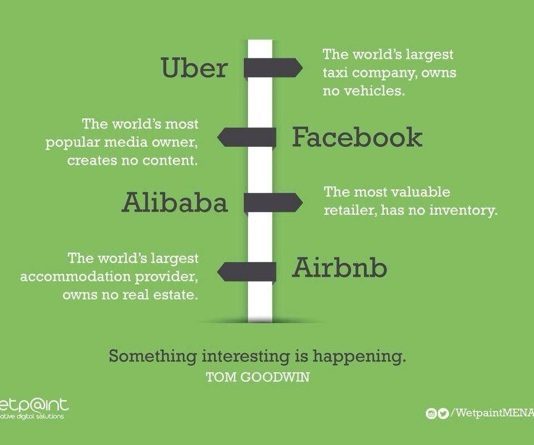
Google, Facebook, Uber and Airbnb: four companies, which became dominant market players in their segment in a very short time. Uber, for example, grew in seven years to the world’s biggest logistics company. Platform-expert Martijn Arets unravels the success formula of these services.
1. Facilitation in stead of control
During the industrial revolution the trend was to centralize both people and resources. To the effect that maximum efficiency could be reached. It used to be he ideal formula, as at the time most products and services where produced by the dozen. Or like Henry Ford stated, “Any customer can have a car painted any color that he wants, so long as it is black.”
The downside of this decentralization was a lack of flexibility; changing existing processes went slow and was burdened by big inventorial investments. When we look at a platform like Airbnb, we see the opposite. Airbnb as a company itself doesn’t invest in property, though connects (private) owners of existing property (which may be rented out for leisure purposes) to people who see the need to rent it. The platform works as an intermediary with a client base, which may grow exponentially, through a (relatively) non-capital-intensive strategy. Facebook, Airbnb, Booking.com and Martkplaats.nl work all in the same way.
The great challenge of a platform is the need for two sides: the demand and the supply. The art of starting a platform is to realize a healthy balance between them. Uber does a smart job. The taxi platform governs the deployment of drivers by using dynamic tariffs. When the demand outgrows the supply, fares are raised. This motivates drivers to get their car started and demotivates the clients to task for a taxi right now. Thus, the supply increases and the the demand decreases, which immediately restores the balance.
Key learning point: Go back to the core of your company and see how you may set up your service as a platform.
2. The innovation process upside down
A second obstacle to platforms is their way to turn innovation processes upside down. Professor in Innovation Studies, Koen Frenken, calls this ‘reverse technology assessment’. He explains, “Normally speaking, an innovation is first studied scientifically, second a public discussion about its desirability takes place, then politics come up with regulations, and finally an innovation is marketed.”
This is process in place with new medicine, airplanes, food or farming methods: first research, then safety tests, next regulations, and finally market introduction. Though with the sharing economy the process is reverted. Companies launch their new platforms first, which will consequently be follow by a normative discussion, and only then scientific research.
The problem is that platforms, by doing so, knowingly violate laws and regulations. Uber knew that UberPop, a gypsy cab service, was illegal. By applying the reversed innovation process, Uber created a satisfied market first, by which it was much harder for public institutions to prohibit the service.
Key learning point: Some impertinence from time to time doesn’t hurt. And sometimes it’s better to ask for forgiveness after the event, than permission up front.
3. Use the newest technology optimally
Many activities we perform by using platforms nowadays, aren’t new. Sharing has always existed. Platforms only lower the thresholds. For example, transaction costs are lowered, and strangers may be trusted, thanks to reviews and reputation scores. The added convenience fosters a rapid increase in usage.
Let’s take uber as an example. Where it used to be troublesome to get a cab, nowadays it can be done with 3 ‘taps’ on your smartphone. The fact that both the driver and you own a smartphone, makes it possible that many operations are automated. The algorithm matches you with the closest driver. At the end of the ride you rate the driver and the driver rates you. This reputation system filters out bad performing drivers and asocial clients in no time. Linking your credit card ensures you that you don’t have to give the payment process a second thought.
Key learning point: Use technology and algorithms to simplify processes and make them self-managing.
4. Extreme focus on creating convenience
One of the key agenda points in the development of online platforms is to create convenience for both the client and the supplier. Processes are becoming simpler and more and more services are being integrated in existing apps. It is even possible to directly order an Uber from Google Maps and also KLM has integrated the Uber API connection into its website.
The next step is to look ahead to the future. The now Uber app links to your agenda and registers your daily rhythm. This in order to give you the right suggestion to order a taxi at the right time.
A Mayor point of interest in this development is of course privacy. To what extent would you be able to trust a commercial party with your personal data? That is something about which start-ups can learn a lot and where existent companies are absolutely well ahead.
Key learning point: See how you may use technology to find ways to serve your clients proactively.
5. Think in categories, not in niche markets
Uber isn’t a taxi company, but a logistics platform, and Airbnb isn’t a renting out accommodations, yet offers “unique (local) experiences”. Though many people talk about Uber as if it is a taxi company, in the mean time they’ve started to deliver food (UberEats) and are developing the platform for self-driving trucks and cars. Airbnb is aiming at the complete travel experience and not only at accommodation; hence the platform newly offers tours. This way platforms embrace the opportunity to become the all-in-one solution in their category, and that doesn’t leave much space for competition.
Key learning point: Think outside your own niche market, but think of all-in-one solutions.
This blog was published in Dutch on Intrapreneur.nl
The post 5 success factors of scalable online platforms like Uber and Airbnb appeared first on Seats2meet.
January 20, 2017
Het is tijd om de verzekeringsindustrie voorgoed te veranderen
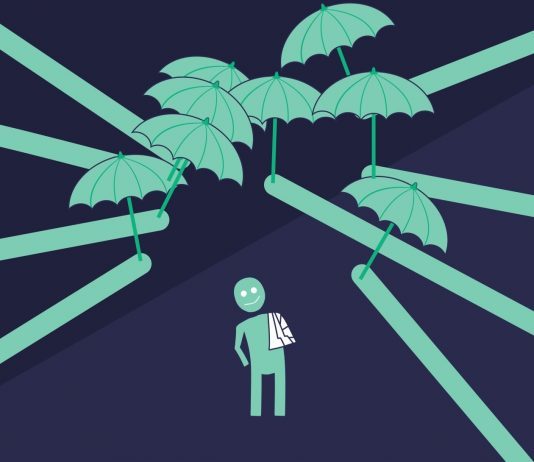
Ooit waren verzekeraars goed in het organiseren van solidariteit binnen gemeenschappen. Dat was gebaseerd op de wil om elkaar te helpen als het tegenzit. Jij helpt mij en ik help jou. Echter zijn de verzekeraars van vandaag grote financiële instellingen geworden die voor zzp’ers ingewikkelde en dure arbeidsongeschiktheidsverzekeringen aanbieden.
Bij CommonEasy weten we dat het beter kan. Wij geloven dat iedereen recht heeft op zekerheid. Daarom gaat het platform van CommonEasy weer terug naar de kern van verzekeren, maar met het gemak van de online wereld. Drie onderscheidende factoren van CommonEasy zijn:
Jij blijft de baas over je geld
Jij bepaalt zelf je spaarbedrag
En je krijgt snel dekking door het delen van netwerken van deelnemers
Maar hoe werkt CommonEasy in de praktijk? Bekijk de uitlegvideo
Onze partners
Inmiddels heeft CommonEasy twee zzp-coöperaties als partner: Zorg & Co en De Coöperatie. Teun Gautier, oprichter van De Coöperatie, vertelt waarom hij bij CommonEasy zit.
Wil jij meer weten over ons vangnet voor arbeidsongeschiktheid? Kom dan naar de Monday Meetup op 30 januari in de Social Impact Factory. We geven om 17u en om 18u15 een workshop (je kan je aanmelden via de links).
www.commoneasy.nl
The post Het is tijd om de verzekeringsindustrie voorgoed te veranderen appeared first on Seats2meet.
January 19, 2017
Bitcoin en de blockchain: de volgende digitale revolutie!?


“Bitcoin en de blockchain zal net zoveel impact hebben als de uitvinding van het internet.” Heeft deze uitspraak ook gelijk jouw aandacht? Zoals dat voor Susanne Pieterse zo was? Ik kwam haar tegen op 9 januari tijdens de Money Monday meetup; een eerste sessie die ik organiseerde in het Permanent Future Lab om gezamenlijk meer te weten te komen over ‘digitaal geld’ waarmee cryptocurrency, zoals Bitcoin, bedoeld wordt. Naderhand publiceerde ze onderstaande samenvatting van de sessie op haar blog over lifehacking.
Wat is Bitcoin?
De Bitcoin is te vergelijken met digitaal cash. Net als munten of bankbiljetten kan de Bitcoin verhandeld worden van persoon tot persoon. Er zitten geen banken of andere instellingen tussen. Het voordeel ten opzichte van de euromuntjes in je portemonnee is dat bitcoins verstuurd kunnen worden via het internet. Probeer dat maar eens met een fysieke munt.
Hoe kom je aan bitcoins?
Net als normaal cash bewaar je bitcoins in een portemonnee, maar dan wel een digitale genaamd ‘wallet’. De wallet-app staat doorgaans op je smartphone. Met een wallet kunt je rechtstreeks bitcoins overmaken naar een andere wallet. Er zijn online wisselkantoren waar je via een iDeal-betaling euro’s kunt wisselen voor bitcoins. Je kunt ook een dienst uitvoeren en je laten betalen in bitcoins. Er zijn al diverse locaties in Nederland waar je kunt betalen met bitcoins, zoals bars en restaurants in de binnenstad van Arnhem. Je pizza via Thuisbezorgd.nl kun je tevens betalen met bitcoins. Voor een bitcoin-transactie betaal je kosten.
Contactloos betalen is toch veel makkelijker?
Ja, absoluut. Maar we hebben het in Nederland wel erg goed voor elkaar. Dat is in andere delen van de wereld wel anders. Daar is het niet vanzelfsprekend dat je een bankrekening hebt of even iets overmaakt met iDeal. In Nederland betaalt een consumenten geen kosten voor een betaling. In de Verenigde Staten kost betalen altijd extra. Voor het opnemen van cash bij de geldautomaat rekent de bank 4 dollar kosten. Betaal je met een creditcard, dan komen er ook kosten bij.
Veel mensen sturen geld naar hun familie in het buitenland via een money transfer. De kosten hiervoor zijn hoog. Vaak duurt het een tijdje voordat het geld er is. Tevens moeten verzender en ontvanger fysiek naar een kantoor om de geld te versturen en te ontvangen.
Bij Bitcoin zijn de kosten laag. Iedereen met een smartphone kan het gebruiken. En het geld is binnen 15 minuten overgeschreven in de wallet van de ontvanger. Overal waar een internetverbinding is, werkt het.
Wat kost een bitcoin?
Het systeem van Bitcoin is gebaseerd op schaarste. Tot 2140 zullen er 21 miljoen bitcoins worden gedolven. Dat delven gebeurt door ‘miners’ die de rekenkracht van hun computers aan Bitcoin geven. Zij worden daarvoor beloond met bitcoins. Hoe meer mensen bitcoins willen, hoe hoger de waarde wordt. De waarde fluctueert sterk. Een bitcoin kan in hele kleine stukjes worden gedeeld. Een bitcoin kost op dit moment ruim 800 euro. Als je voor een tientje bitcoins koopt krijg je 0,00x bitcoin. De wallet rekent het bij een betaling voor je om in de valuta van je keuze, zoals euro, dollar en yuan.
Is Bitcoin veilig?
Als een bitcoin wallet aanmaakt krijg je een persoonlijke sleutel. Die sleutel is een hele lange code, die je kunt opslaan in de vorm van een zin. Deze sleutel moet je veilig bewaren, want deze geeft samen met je wallet toegang tot je bitcoins. Als je je wallet kwijtraakt, ben je de pineut. Maar dat ben je ook als je je gewone portemonnee kwijtraakt. 
January 18, 2017
Buren uit heel Nederland koken voor elkaar via Thuisafgehaald
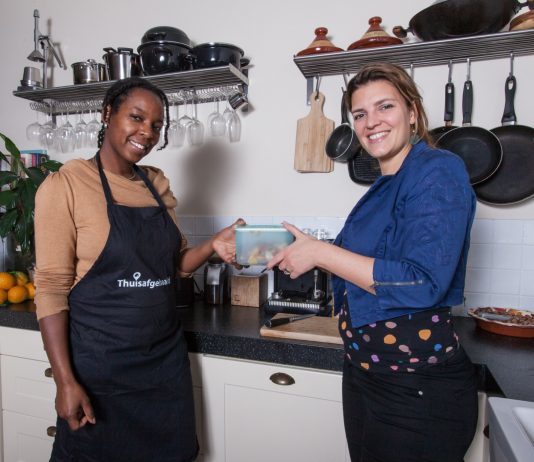
 Een portie lasagne van Stefan of bulgur van Silvia, via Thuisafgehaald.nl kun je maaltijden afhalen bij een buurtgenoot. Sinds 2012 koken buren in heel Nederland voor elkaar. En als het nodig is, wordt het eten zelfs gebracht.
Een portie lasagne van Stefan of bulgur van Silvia, via Thuisafgehaald.nl kun je maaltijden afhalen bij een buurtgenoot. Sinds 2012 koken buren in heel Nederland voor elkaar. En als het nodig is, wordt het eten zelfs gebracht.
De Russische Ilana woont nu 15 jaar in Nederland. Sinds ze kookt via Thuisafgehaald voelt ze zich voor het eerst thuis in haar eigen wijk. Ze heeft geen werk maar komt nu eindelijk in contact met andere mensen. Ze heeft het gevoel dat ze iets voor ze kan betekenen. Ilana lijdt al jaren aan een chronische depressie, maar sinds ze voor haar buurtgenoten kan koken heeft de huisarts haar dosering van haar antidepressiva verlaagd.
Ook als je niet zo mobiel bent is een maaltijd via Thuisafgehaald ook te regelen. De 85-jarige mevrouw Hage ontvangt bijvoorbeeld wekelijks een maaltijd van thuiskok Heike en was al snel een kilo is aangekomen door de voedzame maaltijden. Als zij niet was aangesterkt had ze naar een verzorgingstehuis moeten verhuizen. Nu kan zij langer thuis blijven wonen en geniet ze van de momenten dat Heike de maaltijd komt brengen. Ze vertelde dat als Heike met haar pannetje binnenkomt ze de liefde van haar voelt uitstralen!
Gemiddeld kost een maaltijd € 5, dit zijn de kosten van de boodschappen + wat extra’s voor gas, water, licht en de moeite. Thuiskok Stefan: “Mijn maaltijden kosten ongeveer zes euro per portie. Ik word er niet rijk van, maar haal de kosten er uit. En we eten als gezin gratis. Dat de kosten gedekt worden is fijn, maar het leukste vind ik dat mensen genieten van wat ik maak.
De meeste mensen halen een portie af en eten het thuis op, maar ik bied ze ook wel eens een stoel aan. Ik heb inmiddels vaste klanten die ook wel eens met mij en mijn gezin mee-eten, gewoon hier aan de keukentafel.”
Je buurtgenoten leren kennen door eten met ze te delen, daar komt het op neer. En dat is precies wat Stefan er mee wil bereiken.
Als het je leuk lijkt, kun je ook een keer eten bestellen bij Stefan, of bij een van de andere thuiskoks via www.thuisafgehaald.nl. Jezelf opgeven en koken voor je buurtgenoten kan natuurlijk ook.
The post Buren uit heel Nederland koken voor elkaar via Thuisafgehaald appeared first on Seats2meet.
January 17, 2017
Want to Change the World?
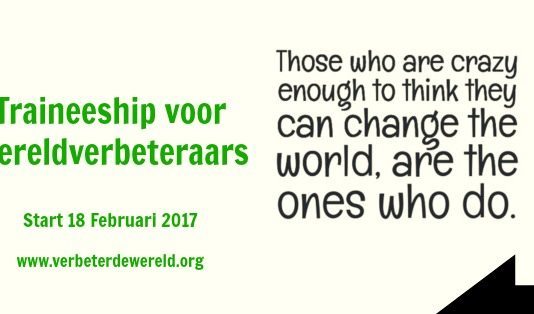
Verbeter de Wereld (Dutch for ‘Improve the world’) is thé traineeship for ambitious young professionals wanting to use their talents for a better world!
Tell me more! Verbeter de Wereld are a group of professional trainers and coaches who offer their expertise through the Traineeship for World Improvers. This program is specifically designed for idealistic Young Professionals who just want more.
The Traineeship takes four months which include two training weekends, and special a closing day and personal coaching throughout the entire Traineeship.
What will I be doing?
Execute a project: within 4 months you will execute an extraordinary world improving project, together with other trainees. The project groups are formed during the first weekend. You decide what cause you will be working on and how you want to shape your project.
Personal growth: you will learn about mission-based project management and communication skills. On top of this frequent feedback will be provided to you learn about yourself as team player, leader and enabler.
Practical idealism: your daily choices have a direct impact on the entire planet. Which choices do you make, and why? We inspire you to take the next step.
Unique: Apart from just focusing on implementing projects that improve the world, this program is about giving meaning to the things we do, personal growth and developing of competencies. Alumni state this is what makes the program unique: next to making a difference there is room for the big questions facing us in life. Through this Traineeship you will become a catalyst for a better world!
Which theme makes your heart beat faster?
Sustainability: future energy supplies, waste management, cradle to cradle
Poverty reduction: education, microcredit, solidarity
Peace and Safety: unity, understanding, democracy
Human equality: acknowledging each other, diversity, love, living together in peace
Something else? In this traineeship you can start making a difference!
When can I start :
First weekend: Saturday morning 18 February – Sunday afternoon 19 February 2017
Second weekend: Saturday morning 8 April – Sunday afternoon 9 April 2017
Closing day: Saturday 17 June 2017
Apply via: www.verbeterdewereld.org
Follow us: https://www.facebook.com/verbeterdewe...
Questions & answers: Rene Sellmeijer: 06-41489289 / rene@verbeterdewereld.org
Unfortunately we currently offer this traineeship only in Dutch
The post Want to Change the World? appeared first on Seats2meet.




